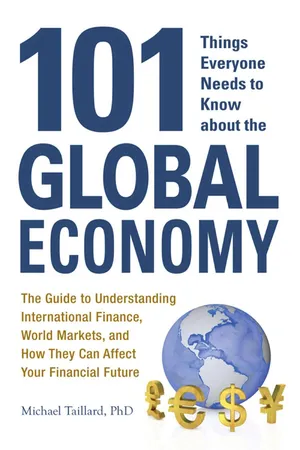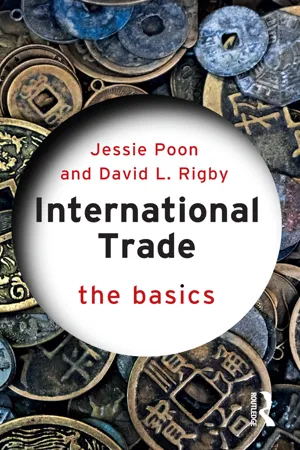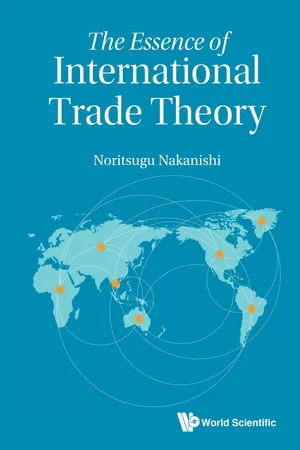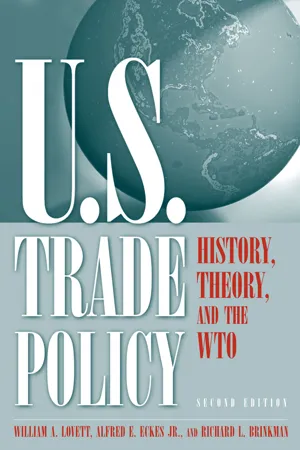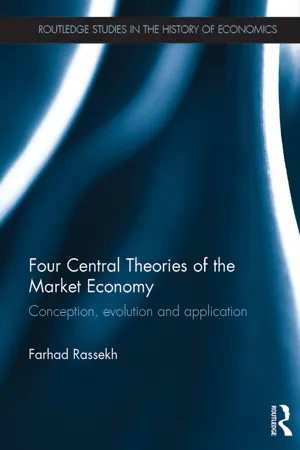Economics
Comparative Advantage vs Absolute Advantage
Comparative advantage refers to a country's ability to produce a good or service at a lower opportunity cost than another country, while absolute advantage refers to a country's ability to produce more of a good or service using the same amount of resources. Comparative advantage focuses on opportunity cost, while absolute advantage focuses on productivity.
Written by Perlego with AI-assistance
Related key terms
7 Key excerpts on "Comparative Advantage vs Absolute Advantage"
- eBook - ePub
101 Things Everyone Needs to Know about the Global Economy
The Guide to Understanding International Finance, World Markets, and How They Can Affect Your Financial Future
- Michael Taillard(Author)
- 2012(Publication Date)
- Adams Media(Publisher)
Relying on absolute advantage for a nation’s economic health is extremely inefficient. As we saw above, absolute advantage in any product is a temporary condition that is eventually eroded by trade. So you shouldn’t get too complacent, even if right now your country can produce more beer more cheaply than anywhere else. Given free international trade and growing demand, it won’t be that long before your six-packs are rising in price and more and more beers from other countries are showing up in your local supermarket.4. COMPARATIVE ADVANTAGE
A nation has a comparative advantage over another nation in the production of some good or service when it has less opportunity cost. In other words, the nation has to give up fewer resources for the production of other goods in order to produce something than another nation does. This not only increases efficiency in resource usage, thereby decreasing the costs for the production of that item, but it also makes the economy as a whole more efficient in its allocation of resources.What You Should Know
Comparative advantage is the primary basis for all sustainable international trade, and the basis for all transactions that take place within a single nation. Imagine for a moment trying to produce everything you need to survive. You have to build your own shelter, grow or hunt your own food, and so on. Alternatively, you can focus on making extra of whatever you’re able to produce the most of, using the resources available to you and trading that surplus for everything else you need. When individuals focus on developing an expertise in just a few skills and doing those very well, it’s called specialization or the division of labor. When this happens on a global scale, where all the companies of a nation focus on performing those functions they can do well using as few resources as possible (meaning cheaply), then it’s called operating within their comparative advantage. Even if a nation doesn’t have an absolute advantage in anything, nations benefit by taking advantage of each other’s comparative advantage.Comparative advantage differs from absolute advantage in that it is more concerned with opportunity cost than financial cost. As we saw above, an absolute advantage tends to be a temporary state of things. Having a comparative advantage means that the nation is specializing, using its resources more efficiently, keeping costs down, and relying on other nations to produce those things that it may not be as effective at making itself. - eBook - ePub
- W. Charles Sawyer, Richard L. Sprinkle(Authors)
- 2020(Publication Date)
- Routledge(Publisher)
CHAPTER 3Comparative advantage and the production possibilities frontierNature, by giving a diversity of geniuses, climates, and soils, to different nations, has secured their mutual intercourse and commerce as long as they all remain industrious and civilized. The industry of the nations, from whom they import, receives encouragement: Their own is also increased, by the sale of the commodities which they give in exchange.David HumeINTRODUCTIONI n the previous chapter, we considered a number of aspects of international trade. We first showed that international trade occurs for the same reason that domestic trade occurs. Next we considered trade as a way for businesses to make a profit and for consumers to obtain lower-priced goods. This initial look at international trade showed that trade is driven by the existence of different prices for goods in different countries. The analysis to this point left one important question unanswered: why are the prices different? To answer this question, we first considered the theory of trade based on absolute advantage. Some countries can produce goods at a lower price because labor in that country is more productive in producing that particular good. Trade based on absolute advantage is deficient in some respects as a complete explanation of trade. To remedy these problems, we then considered the theory of comparative advantage. Countries have a comparative advantage in the production of goods where the opportunity cost of producing those goods is low.While the theory of comparative advantage is quite general, our discussion of the reasons for international trade is not complete. Specifically, we made an assumption in Chapter 2 that is not always realistic. In our previous analysis, we assumed constant costs. This is not an unreasonable assumption in many cases. However, you may recall from Principles of Economics that there are other cost conditions. We start this chapter by analyzing international trade under constant costs in a more rigorous way. Using the same framework, we will be able to consider how differences in the demand for goods in different countries influences the outcome of trade. From that point, we can then show how the existence of increasing costs influences international trade. While the models developed in this chapter cannot cover every conceivable aspect of international trade, they can be used to consider situations that could not be analyzed using the more limited tools in Chapter 2 - eBook - ePub
- D. O'Brien(Author)
- 2017(Publication Date)
- Princeton University Press(Publisher)
Now, so far, all that Ricardo had explicitly done was to show that it might be advantageous for a country to import commodities in which it had an absolute advantage. But, as is so often the case with Ricardo, there is much more implied here. The ratio of labor inputs in England implies that the relative price of cloth and wine will be 1:1.2. The corresponding figures for Portugal will be 1:0.88. Clearly this implies that it will be advantageous to Portugal to send wine to England where one unit of it will sell for 1.2 units of cloth. But the price does not have to be so high. As long as 0.88 of a unit of wine sells for more than one unit of cloth (neglecting transport costs), it will be advantageous for Portugal to obtain its cloth through trade. Similarly, England will gain if it has to give anything less than 1.2 units of cloth for every unit of wine. So that any relative price of cloth and wine between the limits 1:0.88 and 1:1.2 will offer a gain to both countries.Ricardo did not spell all this out. But he had gone far enough to establish a theory of the gain from trade which was clearly distinguished from that based upon absolute advantage. What was now being argued was that there was an advantage in trade even if one country was absolutely more efficient (used absolutely fewer inputs) for both commodities, just as long as it was relatively less efficient in the production of one commodity than of another. The distinction between absolute and comparative advantage may be explained as it was by Haberler.12Take two commodities a and b where subscripts 1 and 2 refer to production inputs in countries 1 and 2. Absolute advantage may then be denoted by Country 1 has an absolute advantage in a (a1 < a2 ) and 2 has an absolute advantage in b (b2 < b1 ). Comparative advantage may be denoted by . Country 1 has superiority in both goods but a greater superiority in good a. The consequence of such a theory was, as J. S. Mill put it, “A thing may sometimes be sold cheapest, by being produced in some other place than that at which it can be produced with the smallest amount of labour and abstinence.”13Now that such a state of affairs should exist at all, clearly involves an assumption which Smith did not make, but which Ricardo, Torrens, and other writers certainly did make: that labor and capital were immobile internationally. They were quite clear that it was this that made international trade distinct from inter-regional trade. As J. S. Mill put it: - eBook - ePub
International Trade
The Basics
- Jessie Poon, David L. Rigby(Authors)
- 2017(Publication Date)
- Routledge(Publisher)
gains from trade .While Smith’s model of absolute advantage establishes the possibility of gains from trade, those possibilities arise only when different countries each possess absolute advantage in the production of at least one commodity. In this respect, Smith’s model provides a rather limited basis for trade: there are many countries that engage in trade that likely have no absolute advantages over the rest of the world. What drives these countries to trade? The answer rests on the concept of comparative advantage outlined by David Ricardo in his 1817 book On the Principles of Political Economy and Taxation .We develop the arguments of comparative advantage using the same two-country, two-commodity, one-input model introduced above. Note how labor productivity is adjusted in this new model. To begin, let us imagine that there is no trade, a situation of autarky , between the two countries A and B. In this pre-trade world we assume that country A uses its labor to make wine and cloth. The amount of wine and cloth that country A can produce depends on the productivity of labor in the wine and cloth industries and on the total supply of labor that is fixed at 100 workers, or more precisely, 100 worker-days. The productivity of labor in the wine industry of country A is assumed to be 100/100 = 1. That is, if all 100 workers in country A produced wine and no cloth they could produce 100 units of wine. The productivity of labor in the cloth industry of country A is also set at 100/100 = 1. Thus, if all the workers in country A specialized in producing cloth, they could produce 100 units in a single day. These production possibilities are mapped in panel a of Figure 2.1 in the form of a production possibilities frontier (PPF). The PPF maps all possible combinations of wine and cloth that might be produced using the available labor in a country. Note that complete specialization in Figure 2.1 - eBook - ePub
- Noritsugu Nakanishi(Author)
- 2018(Publication Date)
- WSPC(Publisher)
A specializes in good 1, exports it, and imports good 2 instead. Conversely, country B specializes in good 2, exports it, and imports good 1. The equilibrium trade pattern becomes such that each country exports the good in which it has a comparative advantage over the other country.Absolute advantage: When aALj< aBLj, we say that country A has an absolute advantage in (the production of) good j over country B. This means that country A has more advanced production technology in good j than country B. It should be noted that the absolute advantage in good j neither implies nor is implied by the comparative advantage in good j. Actually, we can easily construct an example in which country B has absolute advantages in both goods, still country A has a comparative advantage in good 1 (i.e., both aAL1> aBL1and aAL2> aBL2hold, but, at the same time, aAL1/aAL2< aBL1/aBL2holds). As shown above, what determines the production and trade patterns is the comparative advantage; the notion of absolute advantage has nothing to do with their determination (as far as the international labor mobility is assumed away). Therefore, it can be the case that firms with higher technology in one country may lose competition against firms with lower technology in the other country and fail to survive in the trading world.Net export and net import: To show how the trade equilibrium price is determined, we introduce the concepts of the net export curve and the net import curve. For the moment, we concentrate our attention on country A. We regard that Fig. 2.2 illustrates the situation in country A. From now on, we focus on the quantities of good 1.If the world market price p happens to be equal to the autarkic equilibrium priceA, the consumption point will be and the consumption of good 1 be 1 in Fig. 2.2 . However, since international trade is allowed, the production point for p =Amay differ from ; it can be any point on segment y′y′′. If production occurs at y′ = (y′1 , 0), then the production of good 1, y′1 , exceeds the consumption, 1 . In this case, country A can export y′1 − 1 units of good 1 at the world market price. On the other hand, if production occurs at y′′ = (0, y′2 ′), the consumption of good 1, 1 , exceeds the production of good 1, which is zero. In this case, country A has to import all of 1 - eBook - ePub
U.S. Trade Policy: History, Theory, and the WTO
History, Theory, and the WTO
- William A. Lovett, Alfred E. Eckes, Jr, Richard L. Brinkman(Authors)
- 2015(Publication Date)
- Routledge(Publisher)
acquired , is in this respect of no consequence.” (Smith 1937, 425–426; Irwin 1996, 119; and Bloomfield 1975, 458; italics added).Contrary to conventional wisdom and textbook mythology, Adam Smith actually placed the domestic economy and its advance over the international: “According to the natural course of things, therefore, the greater part of the capital of every growing society is, first, directed to agriculture, afterwards to manufactures and last of all to foreign commerce” (Smith 1937, 352, 360, 423; and Irwin 1996, 84). And further, that acquired absolute advantage rests with the industrialization of the domestic economy: “Most opulent nations, indeed, generally excel all their neighbours in agriculture as well as in manufactures, but are commonly more distinguished in the latter than in the former” (Smith 1937, 6; Bloomfield 1994, 111; 1975, 457). Once having acquired absolute advantages inherent in the processes of modern economic growth and industrialization, it is then prudent for a nation to compete in global markets, and from this to gain the benefits of a larger market size, improved productivity, and further technological advances.Certainly, this has been the historic path pursued by Britain and the United States. The Japanese pursued a similar development path, applying policies of a developmental state, which has also served as the model pursued by the “tigers” of East Asia.12 - eBook - ePub
- Farhad Rassekh(Author)
- 2016(Publication Date)
- Routledge(Publisher)
The general industry of the country, being always in proportion to the capital which employs it, will not thereby be diminished, no more than that of the above-mentioned artificers; but only left to find out the way in which it can be employed with the greatest advantage. It is certainly not employed to the greatest advantage when it is thus directed towards an object which it can buy cheaper than it can make. The value of its annual produce is certainly more or less diminished when it is thus turned away from producing commodities evidently of more value than the commodity which it is directed to produce. According to the supposition, that commodity could be purchased from foreign countries cheaper than it can be made at home. It could, therefore, have been purchased with a part only of the commodities, or, what is the same thing, with a part only of the price of the commodities, which the industry employed by an equal capital would have produced at home, had it been left to follow its natural course. (Ibid., p. 457)Smith's insight imparts a central message of the theory of comparative advantage: more productive countries cannot outcompete less productive countries in all commodities and thus do not drive them out of world markets; nor can low-wage countries outcompete high-wage countries in all goods in the global economy. This message, however, became fundamental in trade theory only after Ricardo presented his comparative advantage model.75Appendix II How comparative costs ratios set limits on wages
Haberler (1930/1985) develops a numerical model, which I will adapt to Ricardo's example of “two men” in his footnote introduced above. Recall that Ricardo (1817/1996, p. 95) writes, “Two men can both make shoes and hats, and one is superior to the other in both employments; but in making hats he can exceed his competitor by one-fifth or 20 percent, and in making shoes he can excel him by one-third or 33 percent.” Suppose the “two men” are Pedro and Edward. Pedro has an absolute advantage, and his monthly wage rate is, say, $1000 and Edwards's $800. Labor wages are the only production costs. This example can be summarized in the following table, which also includes the productivity values from Table 2.2 in section 3.1 above:
Learn about this page
Index pages curate the most relevant extracts from our library of academic textbooks. They’ve been created using an in-house natural language model (NLM), each adding context and meaning to key research topics.
